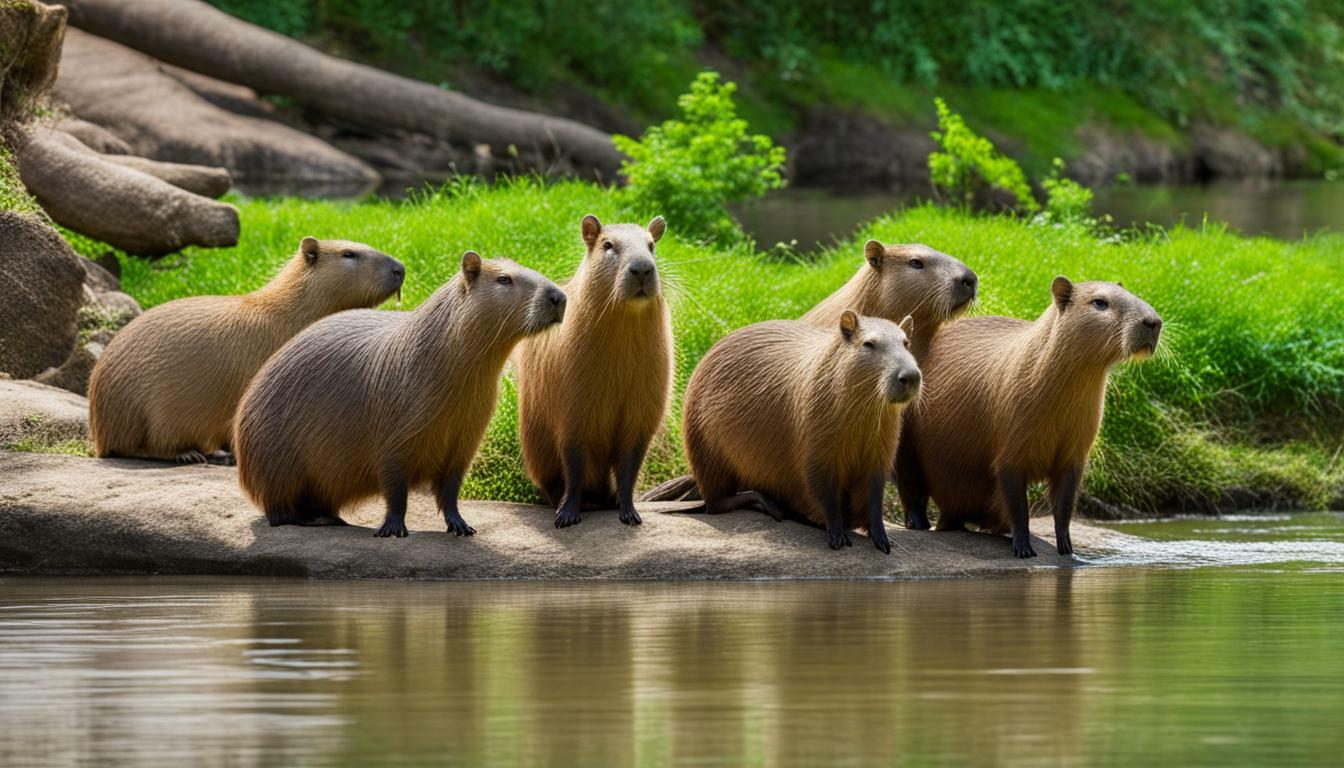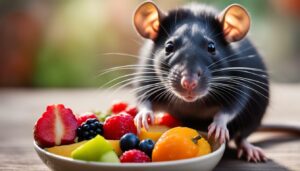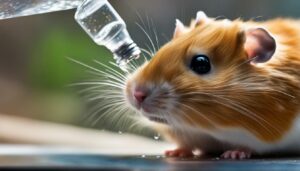Capybaras, the largest rodent in the world, have a lifespan that varies depending on their environment. In the wild, they typically live for 8-10 years, while in captivity, they can live for about 12 years. Various factors contribute to their lifespan, including predators and habitat conditions.
Key Takeaways:
- Capybaras, the largest rodent in the world, have an average lifespan of 8-10 years in the wild.
- Predators such as jaguars, pumas, eagles, and anacondas pose a threat to capybaras and contribute to their shorter lifespan in the wild.
- Capybaras are herbivorous creatures, mainly consuming sea plants, fruits, and tree bark as their diet.
- They have impressive physical abilities, including the ability to stay underwater for up to five minutes and run as fast as a horse on land.
- Capybaras are social animals that prefer to live in pairs or small groups.
Capybara Lifespan in the Wild
In the wild, capybaras have an average lifespan of 8-10 years, which is influenced by various factors including predators and their habitat. Predators such as jaguars, pumas, eagles, and anacondas pose a constant threat to capybaras, making them vulnerable to attacks and reducing their overall lifespan. The natural habitat of capybaras also plays a crucial role in their longevity.
Capybaras typically inhabit areas near bodies of water, such as rivers, swamps, and marshes, where they find safety and food sources. However, habitat destruction due to human activities can have a detrimental impact on their lifespan. As their natural environment diminishes, capybaras face increased challenges in finding suitable habitats and resources, leading to shorter lifespans.
Despite these challenges, capybaras have adapted well to their surroundings. They are strong swimmers and are capable of staying underwater for up to five minutes at a time, which helps them escape from predators and find food. On land, they are surprisingly fast, able to run as fast as a horse. These physical abilities contribute to their survival in the wild but also reflect the constant need to navigate their habitat to avoid danger and secure their longevity.
| Predators | Habitat |
|---|---|
| Jaguars | Rivers |
| Pumas | Swamps |
| Eagles | Marshes |
| Anacondas |
While capybaras face numerous challenges in the wild, their lifespan can be extended when they are in captivity. In controlled environments, where they are protected from predators and provided with proper care and nutrition, capybaras can live for about 12 years. This extended lifespan demonstrates the positive impact of captivity on their well-being.
Understanding the lifespan of capybaras is essential for appreciating their resilience in the face of adversity. Although their average lifespan in the wild may be relatively short, they have adapted to survive and thrive in their natural habitats while continuing to captivate us with their unique characteristics and behaviors.
Capybara Lifespan in Captivity
Capybaras living in captivity generally have a longer lifespan, with an average of about 12 years. The controlled environment, protection from predators, and access to proper care and nutrition contribute to their increased life expectancy. In captivity, these gentle creatures can thrive and live a more fulfilling life.
Proper diet plays a crucial role in the longevity of capybaras. They are herbivorous animals and mainly consume sea plants, fruit, and tree bark. This balanced diet ensures that they receive the necessary nutrients to support their overall health and well-being. Captive capybaras are provided with specially formulated diets that mimic their natural food sources while also meeting their nutritional requirements.
Capybaras’ ability to adapt to their surroundings, even in captivity, is remarkable. They possess unique physical abilities that aid in their survival and overall lifespan. Capable of staying underwater for up to five minutes, capybaras take advantage of their semi-aquatic nature and rely on water for both protection and sustenance. On land, they can run as fast as a horse, using their agility to escape potential threats.
| Factors contributing to capybara lifespan in captivity: |
|---|
| Controlled environment |
| Protection from predators |
| Proper care and nutrition |
| Availability of a balanced diet |
| Physical abilities – underwater survival and speed on land |
While captivity provides a safe haven for capybaras, it is essential to address the conservation efforts required to protect their natural habitat. Some regions still hunt capybaras for their meat, posing a threat to their long-term survival. Conservation initiatives aim to preserve their habitat, raising awareness about the importance of these gentle giants in the ecosystem and ensuring their continued existence for future generations to admire and learn from.
Capybara Diet and Lifestyle
Capybaras mainly eat sea plants, fruit, and tree bark, which contribute to their overall health and longevity. Their herbivorous nature allows them to thrive on a diet consisting of various vegetation found in their natural habitat. Sea plants provide essential nutrients and minerals, while fruits offer a source of hydration and additional vitamins. Tree bark, on the other hand, aids in digestion and serves as a source of fiber.
In addition to their diet, capybaras lead a relatively active lifestyle. They spend a significant amount of time in the water, where they can stay submerged for up to five minutes. Their aquatic abilities allow them to escape from predators and regulate their body temperature. When on land, capybaras are surprisingly agile, capable of reaching speeds comparable to that of a horse. This speed provides them with an advantage when evading threats in their habitat.
Capybara Aging Process
As capybaras age, they experience a natural aging process. This process can be observed through various physical changes, such as graying fur and a decrease in overall energy levels. While the average lifespan of capybaras in the wild is around 8-10 years, capybaras in captivity tend to live longer, with an average lifespan of about 12 years.
The aging process of capybaras is influenced by several factors, including genetics, environment, and diet. Providing them with a well-balanced diet and ensuring they have access to proper care and nutrition can contribute to their overall well-being and longevity. Additionally, their social nature and the presence of companionship can also play a role in their lifespan and overall quality of life.
| Fact | Information |
|---|---|
| Species | Capybara (Hydrochoerus hydrochaeris) |
| Size | Approximately 4.5 feet long and 2 feet tall |
| Weight | Between 77 and 146 pounds |
| Native to | South America |
| Conservation status | Least Concern (IUCN) |
In conclusion, capybaras have a varied diet consisting of sea plants, fruit, and tree bark, which contributes to their overall health and longevity. They are capable of staying underwater for extended periods and can run as fast as a horse on land. While their average lifespan in the wild is relatively short due to predation, capybaras in captivity tend to live longer. Proper care, nutrition, and social interaction are vital to ensuring their well-being and maximizing their lifespan.
Capybara Behavior and Social Structure
Capybaras are highly social animals that prefer to live in pairs or small groups, and their social behavior plays a role in their lifespan and habitat. These semi-aquatic rodents have a complex social structure that revolves around strong bonds and cooperation within their groups.
In their natural habitat of wetlands, marshes, and forests of South America, capybaras thrive in environments with abundant water sources and vegetation. They form cohesive social units known as herds, which consist of one dominant male, several females, and their offspring. Within the herd, capybaras engage in various social behaviors, such as grooming each other, vocalizing, and sharing communal fecal sites to mark their territory.
Their social nature not only provides companionship but also enhances their survival chances. By living in groups, capybaras can work together to spot predators, such as jaguars and anacondas, and protect their young. This cooperative behavior helps to mitigate the risks they face in their natural habitat, ultimately influencing their lifespan and overall well-being.
| Social Behavior of Capybaras | |
|---|---|
| Grooming | Capybaras spend time grooming each other, removing parasites and strengthening social bonds. |
| Communal Living | Living in pairs or small groups allows capybaras to vigilantly watch for predators and protect their young. |
| Shared Territory | Capybaras mark their territory by using communal fecal sites, demonstrating social cohesion within their groups. |
Overall, the social behavior and structure of capybaras are essential aspects of their lifespan and habitat. By fostering strong connections and relying on cooperative strategies, these remarkable creatures enhance their chances of survival and contribute to the thriving ecosystems they call home.
Capybara Predators
Capybaras face threats from predators such as jaguars, pumas, eagles, and anacondas, which can impact their lifespan in the wild. These predators are skilled hunters and are known to target capybaras as a source of food. Jaguars and pumas, being large and powerful cats, pose a significant threat to capybaras, especially when they are near water sources where capybaras often gather.
Eagles, with their sharp talons and excellent eyesight, are known to swoop down and snatch capybaras away, especially the younger and more vulnerable ones. Anacondas, as formidable constrictor snakes, are also predators of capybaras, using their strength to suffocate and devour them.
Due to the presence of these predators, capybaras in the wild must constantly be on the lookout for danger. They have developed vigilant behavior and rely on their strong sense of hearing and smell to detect potential threats. Capybaras are known to form groups, which enhances their chances of survival as they can alert each other to the presence of predators.
| Predators | Potential Impact on Lifespan |
|---|---|
| Jaguars | High |
| Pumas | High |
| Eagles | Moderate |
| Anacondas | Moderate |
Although capybaras have evolved to adapt to their surroundings, their lifespan in the wild can be significantly influenced by the presence of these predators. Humans play a crucial role in preserving the habitat and ensuring the conservation of capybaras, allowing them to thrive and maintain a healthy population in their natural environment.
Capybara Physical Abilities
Capybaras, the largest rodent in the world, possess remarkable physical abilities that contribute to their survival and lifespan in their natural habitat. They are capable of staying underwater for up to five minutes, thanks to their well-adapted respiratory system. This ability allows them to escape from predators and find food sources underwater, such as aquatic plants and vegetation.
On land, capybaras exhibit impressive speed, comparable to that of a horse. This agility helps them evade predators and navigate their surroundings efficiently. Their powerful hind legs and webbed feet contribute to their exceptional running ability, enabling them to quickly flee from potential threats.
The combination of their extended time spent underwater and their impressive speed on land gives capybaras a unique advantage in their environment, allowing them to maximize their chances of survival and ultimately contribute to their lifespan.
Hunting and Conservation
Capybaras are hunted for their meat in some regions, but there are also conservation efforts in place to protect their habitat and support their lifespan in the wild.
In certain areas, capybara hunting is a common practice due to their large size and the nutritional value of their meat. However, it is important to keep a balance between hunting and conservation to ensure the long-term survival of these fascinating creatures.
Conservation organizations and local authorities have implemented measures to protect capybara habitats, such as establishing protected areas and implementing regulations on hunting practices. These efforts aim to preserve the natural habitat of capybaras, which is crucial for their survival and overall well-being.
Conservation Efforts
Conservation programs focus on educating local communities about the importance of capybara conservation and promoting sustainable hunting practices. These initiatives also aim to raise awareness about the essential role capybaras play in their ecosystems.
By protecting their natural habitats from deforestation and urbanization, these efforts help maintain the balance of local ecosystems and ensure the availability of resources for capybaras and other wildlife.
Additionally, conservation organizations collaborate with researchers and scientists to gather valuable data on capybara populations, behavior, and habitat requirements. This information is used to develop effective management plans that support capybara populations and promote their long-term survival.
| Conservation efforts: | Protecting capybara habitats |
|---|---|
| Educating communities about sustainable hunting practices | |
| Gathering data on capybara populations and behavior | |
| Developing effective management plans |
Conclusion
In conclusion, capybaras have an average lifespan of 8-10 years in the wild, but can live longer in captivity, where they are protected from predators and receive proper care and nutrition.
Capybaras, the largest rodent in the world, face numerous challenges in the wild that contribute to their shorter lifespan. Predators such as jaguars, pumas, eagles, and anacondas pose a constant threat to their survival. However, in captivity, where they are shielded from these predators, capybaras can live for about 12 years.
These herbivorous creatures have a specialized diet comprised of sea plants, fruit, and tree bark. Their nutrition plays a vital role in ensuring their overall health and longevity. With access to proper nutrition in captivity, capybaras can thrive and live longer lives.
Capybaras are highly social animals that prefer to live in pairs or small groups. Their strong social structure promotes a sense of security and well-being, which can contribute to their extended lifespan. In captivity, they are often provided with opportunities for social interaction, further enhancing their quality of life.
Conservation efforts are crucial for the long-term survival of capybaras. While some regions hunt capybaras for their meat, steps are being taken to protect their natural habitat and ensure their preservation. By safeguarding their environment, we can help maintain a sustainable population and protect these fascinating creatures for future generations.
FAQ
What is the average lifespan of a capybara?
The average lifespan of a capybara is 8-10 years.
What are the predators that contribute to the shorter lifespan of capybaras in the wild?
Capybaras face threats from predators such as jaguars, pumas, eagles, and anacondas, which can contribute to their shorter lifespan in the wild.
What do capybaras eat?
Capybaras are herbivorous creatures and mainly eat sea plants, fruit, and tree bark.
How long can capybaras stay underwater?
Capybaras are capable of staying underwater for up to five minutes.
How fast can capybaras run on land?
Capybaras can run as fast as a horse on land.
Do capybaras prefer to live alone or in groups?
Capybaras are social animals that prefer to live in pairs or small groups.
How long can capybaras live in captivity?
In captivity, capybaras can live for about 12 years.
Do people hunt capybaras for their meat?
Yes, in some regions capybaras are hunted for their meat.




